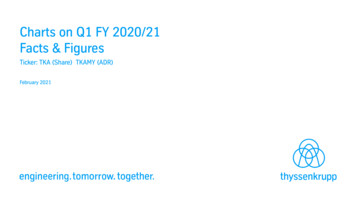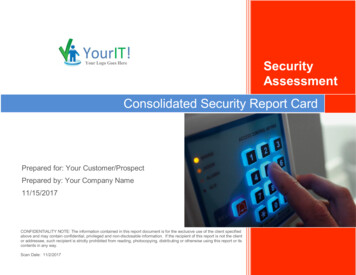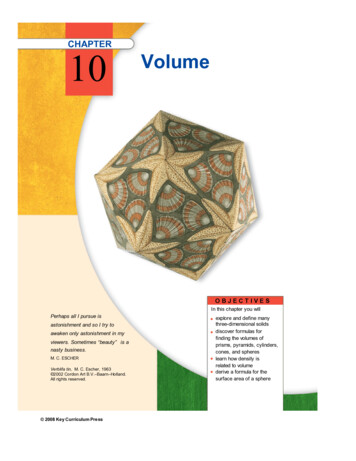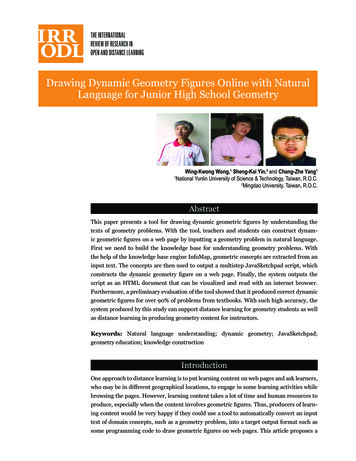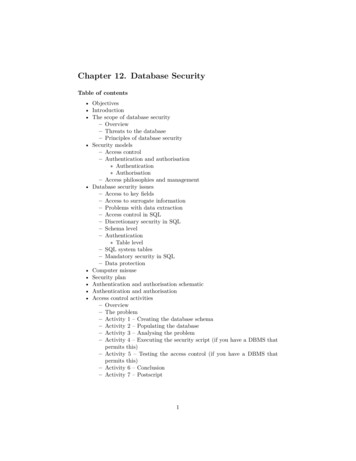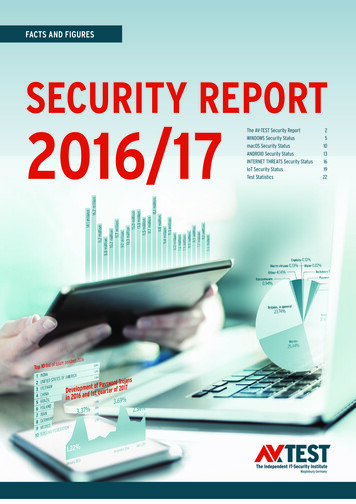
Transcription
FACTS AND FIGURESSECURITY REPORT2016/17The AV-TEST Security ReportWINDOWS Security StatusmacOS Security StatusANDROID Security StatusINTERNET THREATS Security StatusIoT Security StatusTest Statistics251013161922
FACTS AND FIGURESAV-TESTTheSecurity ReportThe best news right off the bat:Compared to the previous year,the detection systems of AV-TEST showeda slight decline in the developmentof malware programs for the year 2016.Overall, that is a pleasing trend, howeverby no means any reason to celebrate,as evidenced by the AV-TEST Institute‘sstatistics of this year‘s Security Report.Declining malware statisticsIt remains positive to note that the declining malware trend in 2016provided some relief, at least quantitatively. Thus, compared to 2015,detection systems were required to seek out and defend against 14% fewermalware samples. In total, this amounted to precisely 11,725,292 fewer newlydeveloped malware programs than in the previous year. It should not beforgotten, however, that the volume of newly developed malware in 2016 stillrepresented the second-highest since the beginning of measurements bythe AV-TEST systems. In addition, 2015 saw skyrocketing growth in malwareprograms and in comparison to 2014, practically a doubling of the samplestatistics. The overall number of malware programs for all operating systemscurrently exceeds 640 million.Without wanting to belittle the positive trend for 2016, the fact remains thatthere have been several short-term downward trends since the beginning ofmeasurements in 1984, a total of six times, without seriously influencing theclear, long-term trend – towards more malware. Despite declining numbers,in 2016, the AV-TEST analysis systems still recorded an average of 350,000new malware programs per day, i.e. roughly four new malware samples persecond. An assessment of the threat potential cannot be meaningfully madeon the analysis of quantitative factors alone. But more on that topic in thecourse of this report.Malware detection sortedby operating systems2016127.5 million144.0 million143.1 millionOverall development of malwareprograms in the last 10 years2014 20152016Q1 2017WindowsWindows83.2 million201369.96%77.22%200622009 www.av-test.org48.0 million18.2 million17.6 million2010 2011201234.4 million2007 200812.4 million8.4 million5.9 million1.0 millionQ1 2017Android 5.65%Android 5.83%Other 24.39%Other 16.95%
Yet not only with respect to declining numbers in the overall field of malware,last year is remarkable. Even within the malware classes detected byAV-TEST, as well as among the developments of attack targets, the year 2016represents a significantly measurable watershed, and clear trends can beidentified:The quantity of malware codes programmed exclusively for Windows systemsis declining. Attackers are increasingly developing malware programs for14.1 million16.2 million11.2 million8.8 million10.2 million11.7 million9.7 million10.3 million13.0 million13.0 million11.5 million11.7 million15.1 million11.8 million9.4 million11.0 million8.0 million7.6 million7.5 million8.0 million8.9 million7.7 million9.2 million8.6 millionTotal occurrence of new malwareQuality, not quantity?other operating systems. Compared to the previous year, their number isincreasing by just under 10%, whereas the number of pure Windows malwareis declining by just under 13%.Mai 2015April 2017Windows remains the most widely attacked operating system. In the year2016, as many as seven out of ten newly programmed malware programsLinux systems were under fire in 2016 as well: The number of attackingtargeted the Microsoft platform.malware programs tripled compared to the previous year.Apple devices are more and more under fire: Compared to the previous year,Due to the rapidly increased numbers of potentially unwanted applicationsthe quantity of malware for macOS has tripled.(PUAs) with which the advertising industry spied on the surfing behavior ofusers in the years 2014 and 2015, the AV-TEST researchers dedicated a separateUsers of Android devices are also subject to a fast-growing quantity of malware:chapter to this class of malware in the last Security Report. However, theCompared to the previous year, the number of malware programs targeting thenumber of new PUA samples decreased by half in the year 2016, compared tomyriad of devices with Google‘s operating system has more than doubled.the previous year, to a mere 22,394,064 newly registered samples.19,535,319Development of Android malwareTotal number of malwareNew malware12,988,9193,091,022169168January 20111,422,884279,997May 2014June 2016498,789April 20173
FACTS AND FIGURES62,269,707PUA developmentin the last 10 years22,394,06464,6822006201120142016Trend 2017This Security Report encompasses not only the data status for theAccording to initial forecasts, there will be a reversal of the hopefulyear 2016 but also takes into account the measurement results of thetrend for Windows users, Because the declining rate of attack of 2016AV-TEST analysis systems for the first quarter of 2017. Thus it is alreadyis not being confirmed by the new measurement results of the AV-TESTpossible to recognize trends for the current year, backed up by data.systems. In the first quarter of 2017, the number of malware programswas on the upswing again, currently by just over 7% compared to theThe Q1-2017 numbers confirm the trend that Apple users will not findannual value of the previous year.pleasing. The rising attack statistics already observable in 2016 areincreasing further – by a significant rate: Thus, the overall number ofThe trend towards a decline in the number of PUA samples wasmalware programs for macOS doubled within the first four months ofconfirmed in the first quarter of this year. In April, the AV-TEST systemsthis year! There was also a marked increase in the recorded attacksdetected a mere 724,633 samples. The last result that low was in Marchon Linux systems, which are often also connected to the Internet2013. Despite the enormous decline, it is still too early for anyoneunprotected like computers under macOS. For attackers, obviously ato let down their guard, and the experts at the AV-Test Institute willworthwhile target.continue observing the PUA trend.In-depth analysis of the overall numbers presented here can be found inthe individual chapters of the Security Report.4 www.av-test.org
WINDOWSSecurity StatusOver 600 million adversaries for WindowsDespite a significant decline in the number of malware samples detected bythe AV-TEST systems, there is no reason for Windows users to let down theirguard. Windows is and will remain the most frequently attacked operatingsystem. It is true that the number of malware samples in 2016 declined by15% compared to previous year. However, the fever curve rose again by 7%in the first quarter of 2017. At the time this report was concluded at the endAlso in 2016, the operating systems of June 2017, there were already 600 million malware programs detectedby AV-TEST targeting the frequently used operating system from Redmond.of Microsoft remained the number one Without good virus protection, the Internet is by no means safe anymore.target of criminal online attacks. However,Viruses, worms and Trojansthe number of attacks declined by 13%One look at the growth of Windows malware indicates precisely which typescompared to previous year. Why? of malware programs were the most lucrative for cyber criminals in 2016.An analysis of the AV-TEST measuring Because just as any other product on the market, malware programs alsoneed to turn a profit for their developers. Only malware offering a properresults provides the answer. return on investment is worth further development, i.e. investing time andmoney. The economic success of malware can be gleaned from severalkey parameters.Distribution of malwareunder Windows in 2016Already the mere frequency of occurrence of a malware code can provideinformation on how successful it is. Thus, in 2016, traditional virusesdominated the malware market for Windows. With more than 37%, oneExploits 0.10%Dialer 0.02%3.9 million5.3 million4.1 million3.8 million3.2 millionWorms4.9 million4.8 millionViruses37.60%4.0 million23.74%5.0 millionTrojans, in general4.7 million6.9 millionBots 0.84%3.4 millionScripts 3.42%4.2 million0.94%Development of new malware forWindows in 2015 – Q1 20174.1 millionPassword Trojans 2.74%Ransomware3.9 millionBackdoors 1.00%Other 4.14%5.3 millionMacro viruses 0.01%25.44%January 2016April 20175
FACTS AND FIGURESout of three malware samples represented this class. One reason for thisTrojans were also heavily represented in 2016, with over 23%.naturally lies in the method of their proliferation: As non-independent2.74% password Trojans, along with 0.94% ransomware are added to whatprogram routines that only reproduce upon activation through the victim,is already a heavily-distributed class of malware. Because both malwareby infecting more and more program files, they are destined for explosive,families of the “Trojan“ class were classified separately in this report,often uncontrollable proliferation already in the program code. However, thisdue to their significance.type of proliferation makes it easier for scan engines to detect maliciouscodes like these. In order for viruses to be successful, they therefore need toappear in numbers, as unlike other malware programs, they are not capableof controlled distribution.Ransomware: the high-tech malwareThere is no indication based on proliferation statistics that 2016 was alsothe “year of ransomware“. Comprising not even 1% of the overall share ofWorms also occurred on a massive scale in 2016. 25.44% of all malwaremalware for Windows, the blackmail Trojans appear to be more of a marginaldetected could be classified in this malware class. Cyber criminals appreciatephenomenon. The fact that this assessment was already quite wrong in thethe self-replicating malicious code above all due to its high speed ofprevious year can be explained by this class of Trojan‘s mode of action, alongproliferation and the wide array of possible functions. Computer worms canwith the damage caused by this Trojan class. In order to generate the desiredutilize practically any possible path for infecting systems. Thus, they canprofits for its developers, no distribution comparable with traditional virusesproliferate using infected USB sticks, within networks, as well as a drive-byis necessary: ransomware involves “high-tech malware“, which seeks itsor direct download and via email. On infected computers, the download anyvictims above all in a targeted business environment. For instance, emailsadditional malicious code, i.e. Trojans.infected with ransomware are sent out almost exclusively on weekdays, asproven by the measurement results of the AV-TEST systems.Development of Windows ransomware in 2015 – Q1 201799,01898,31678,032106,626January 20156 www.av-test.org113,195May 2016November 2016April 2017
Highly-complex encryptionHighly complex and highly flexibleThe malware samples encrypt files or entire computers with highly-complex,Yet the selective distribution also manifests the performance capabilitystate-of-the-art encryption protocols. In doing so, high key lengths are used,of ransomware: With targeted attacks, cyber criminals in 2016 took aim ate.g. for the RSA cryptosystem, keys between 1024 and 4096 bits, for ECDHcritical sectors; in particular, public administrations, healthcare systemup to 192 bits and for AES up to 256 bits – which means these keys virtuallyand retailers became victims of selective ransomware campaigns, mostlycannot be cracked. What‘s more, blackmail Trojans use sophisticated servertriggered by email attachment. The precision with which criminals are ableinfrastructure for generating, administering and issuing the keys with whichto deploy ransomware is seen in the attacks by the ransomware GoldenEyevictims can decrypt files and computers against ransom payment. Practicallyat the beginning of December 2016. In the first wave, the malware disguisedany available online currency, including its anonymous server infrastructure,as a job application email attacked almost exclusively human resourcecan be used for processing the online blackmail. In this way, massivedepartments of companies.numbers of low blackmail sums between 100 and 500 Euros can be extortedand laundered through currencies such as UCash and PaySafeCard. But largeThe fact that ransomware is also suited for mass infections was stunninglysums, such as during the online blackmail of the Hollywood Presbyterianproven by the WannaCry attacks in May of this year with more than 230,000Medical Center in Los Angeles in February 2016, are also easy to extort. Theinfected widows computers in over 150 countries. This case shows the levelcyber criminals cashed in on the blackmail sum of 15,000 Euros conveniently,of development standards such malware has reached, which criminals leaseanonymously and free of charge via bitcoin.as a service. Thus, WannaCry infected computers via zero-day exploits, whichthe US intelligence agency NSA previously used to eavesdrop on computersworldwide. Through a break-in by the hacker group “The Shadow Brokers“,these Windows exploits hoarded by the NSA became freely available overthe Internet and were utilized for the ransomware WannaCry. While Microsoftquickly offered patches for the operating systems involved, operating systemupdates, along with regular backups, are often neglected by consumers andcompanies alike. As a result, large sections of the British healthcare system,including several hospitals, the large Spanish provider Telefonica, as well asthe German railway company, Deutsche Bahn, proved to be far too vulnerable.Development of Windows WannaCryMay 10 – 17, 20171551337012283291May 10, 20173May 17, 20177
FACTS AND FIGURESAttacks on the SWIFT banking systemPassword and banking Trojans also exhibited an interesting trend in 2016.While the proliferation (2.74%) of these extremely specialized forms ofDevelopment of Windows password Trojansin 20168.21%malware slightly declined overall compared to the previous year (3.02%),it is in no proportion to the damage caused. This was significant, especially4.44%at the beginning of the year. Already in February 2016, the Bangladesh CentralBank lost over 81 million through a malware attack. Also in February, asimilar attack was launched against the New York Federal Reserve. But itdidn‘t stop there.6.86%As seen by the proliferation of password and banking Trojans measuredJanuary 20152.61%May 2016December 2016by AV-TEST, in the first quarter of last year, there were extremely manysamples of similar malicious codes active. Some of them were most certainlytheir name, as stated in the letter. The Brussels company, however, declined toused for attacks on the SWIFT (Society of Worldwide Interbank Financialdisclose which banks were involved and how high the financial losses were.Telecommunication) banking network. Using special malware, criminals gainedAt the end of April, SWIFT issued a relevant security update.access to banking computers connected to the payment system. The Belgianservice provider later confirmed this also in a warning to its customers, 3,000The monetary success of banking Trojans is obvious: In proportion to thefinancial institutions around the globe. The attackers were alleged to have beeneffort, the attack on a few SWIFT users is naturally far more lucrative thanable to assume the identity of authorized users and engage in transactions inmass attacks on consumer PCs or computers of small enterprises.TOP 10 Windows malware 2016The Top 10 Windows malware ARITESALITYLAMERMIRASMALL www.av-test.org7,628,795Because viruses, worms and Trojans were among the most widely distributed5,689,139malware samples in 2016, it is hardly any surprise that the Top 10 Windows5,020,3833,092,764malware samples were made up of the classes.Once again this year, the Windows worm Allaple, active since 2006, defended2,890,132the number one spot on the ranking of most widely-distributed malware.1,811,675It successfully proliferates when infected websites are visited. Once it has1,514,886penetrated a Windows system, it replicates itself from computer to computer,1,422,2291,364,7631,284,994even in password-protected networks, whereby as a polymorphic malwaresample, it constantly changes its program code, which makes detecting themalware more difficult. Its various samples comprised over 15% of the entiremalware detection for Windows systems!
Virut, Ramnit, Parite, Sality, Lamer and Small involve computer viruses in atraditional sense. They infect vast number of files and proliferate throughPUA: Windows spying on the declinedifferent channels, including infected websites, PDF downloads and evenIn concluding the chapter, there is a positive trend: The spying of Windowsinfected files on portable storage media such as USB sticks.users by means of spy programs through the advertising industry wasnoticeably curtailed in 2016. And this trend has continued in the first quarterRanked No. 4, Virlock is a truly sophisticated piece of program code amongof this year. This development is even more significant when including thethe Top 10. This ransomware is constantly being further developed anddata from the year 2015: Whereas Windows users wanting to protect theirbelongs to the few programs that can encrypt not only individual files butprivacy were still confronted with 6 million new samples of potentiallyalso complete systems. What‘s more, variants of Virlock do not functionunwanted applications in January 2015, their rate had dropped to belowexclusively as ransomware but can also infect files and thus proliferateone-sixth by April 2017.like a virus. In this manner, Virlock struck cloud storage systems in 2016 byproliferating via infected files, which were synchronized by several users percloud.Trend 2017Development of PUA for Windowsin 2016 Q1 20175,822,755In the first quarter of this year, there‘s been a clear trend towardsmore traditional viruses for Windows, the share of which in the malwaredistribution compared to 2016 is increasing from 37 to 46%. Thenumber of Windows Trojans also considerably increased in the firstquarter of 2017, climbing from 23 to over 30%. This trend is also639,989followed by the number of detected ransomware samples, growing byone-third to 1.55% and is seeing a decline in Internet worms, whichwith a percentage drop from 25 to 6% are clearly among the losers inthe malware market.January 2015April 2017AV-TEST GmbH regularly evaluates on a bimonthlybasis all relevant antivirus solutions for Windowson the market. The latest test results can bedownloaded for free on the website under .9
FACTS AND FIGURESmacOSSecurity StatusAs safe as a bank?With an increase rate of over 370% compared to the previous year, it is noexaggeration to speak of explosive growth. However, it is also important tokeep an eye on the overall number of malware programs with which criminalstry to cheat Mac users: Whereas in 2015 there were a moderate 819 differentmalware threats targeting macOS, Apple users in 2016 already had to protecttheir devices from 3033 malware samples.Apple‘s operating system already shed themyth of absolute security several yearsago, and not even absolute Mac fans stillventure onto the Internet unprotected.Which is a good thing, because the numberof malware samples for computers fromCupertino exploded in 2016.As a proportion to hundreds of millions of malware programs for Windows,that still sounds harmless. But it indicates a dangerous trend, as a massiveboost in malware samples for macOS simply means that this market isbecoming increasingly more interesting for criminals. In other words: Thepeaceful days for Apple users are now gone, if not already in 2014 with themass infection of Macs with the Flashback Trojan. However, some Mac usersstill trust in a false sense of security which was also fueled by advertisingclaims from Apple.Distribution of malware for macOS in 2016Bots 0.03%Viruses 0.16%Worms 0.36%Rootkits 0.07%Password Trojans 0.46%Ransomware 0.07%Scripts 2.24%Exploits 1.75%1,2891,7489.26%1,769Malware development for macOSin 2016 Q1 2017BackdoorsJanuary 201610 53Trojans, in generalApril 2017
Cyber criminals in thedevelopment phaseDevelopment of macOS Trojans, in general,in 2016 Q1 20171,743The growth in the number of malware samples began in December 2016.Prior to that, the number of malware threats was practically at the level ofthe previous year. This means that since then, cyber criminals have been inthe experimental phase, trying out which malware and how much time andeffort are worthwhile for infecting the operating system from Cupertino. Thisassumption is also confirmed by the distribution of various malware samplesand their development.66January 2015196February 2016150April 2017Unlike with Windows computers, cyber criminals obviously do not considertraditional viruses useful for use on Mac systems. So the share of thismalware class is extremely small at 0.16%. Among other reasons, this mayalso be due to the fact that the software architecture of the operating systemis not particularly suited for the proliferation patterns of this malware.Development of macOS Backdoors250in 2016 Q1 2017197Criminals seem to be more interested in trying to gain access to economicallyexploitable data through backdoors. In the experimental kitchens for Macmalware, the backdoor programs enabling secret access to third-partysystems made up a total of 9.26% of all malware in 2016. This was exceededin 2016 only by the extreme number of Trojans, which criminals obviouslybelieve will have the greatest success for macOS: 86.12% of all Apple malware5threats belong to this class – by contrast, the share of blackmail TrojansJanuary 201525February 2016April 2017(0.07%) and password Trojans (0.46%) is still negligible.Distribution of malwareunder macOS in 2016Malware 0.67%Trend 2017To enable better analysis of this trend, it is worth looking at thestatistics of the first quarter in 2017. They indicate a wavelikeoccurrence of large quantities of bots with spikes at the end of lastyear and the beginning of this year, as well as identical patterns withTrojans. And this is a telltale sign that criminals are now in the trialphase of relevant malware, testing which malicious code delivers themost relevant economic results. The second quarter may already beginto show a clear trend in this area. One thing can already be said for surePUA99.33%based on the statistics for the first quarter of 2017, however:The attacks on macOS are increasing. Compared to the previous year,the number of malware samples has continued to increase, this timeby over 140% to a total number of 4348.11
FACTS AND FIGURESTop 10 of the Mac Malwaretargets OS-X users and encrypts documents, entered Mac computers, amongFlashback, an old nemesis, leads the ranking of Mac malware. The malwarethe sneaky part: After the infection, KeRanger waits three days before theprogram, known since September 2011, apparently cannot be eradicated andmalware begins encrypting documents.other methods, as a disguised BitTorrent software transmission. Here‘sis constantly being further developed. Originally disguised as an Adobe flashinstallation file, the Trojan later sneaked through unpatched Java securitygaps as a drive-by download in the browser onto the computer. Flashbackcontinues to enjoy a wide proliferation with more than one out of four Macmalware registered by AV-TEST systems last year being a Flashback sample.Mac users spied onApparently the data of Mac users is extremely lucrative to the advertisingindustry. At least, it is difficult to reach any other conclusion based on theshare of PUAs in the overall number of threats for Apple‘s operating system.Because in the overall distribution, the massively increasing number ofIt is indeed true that the share of blackmail Trojans is negligible in theoverall number of Mac malware threats, but that statistic alone says nothingabout the success of a malware program. The best example is Number 3among 2016 malware threats, one of the first ransomware samples for Applecomputers. Already in the last security report, AV-TEST made reference tomalware samples for Mac OS does not even constitute 1%. With over 99%, themajority of the malware threats were clearly from PUA samples.One look at the growth of the spy tools in the advertising industry revealsa dramatic rise in the sample numbers in the fourth quarter of 2016. In theKeRanger, which in the first two quarters of 2016, as a newcomer, alreadyclimbed to Number 8 among the Top 10 malware. The malware threat, whichabsolute peak phase in November, the number of new samples reported bythe AV-TEST analysis systems was just under the hundred thousand mark.Since then, it has experienced an equally dramatic plummet, recovering atTOP 10 macOS malware THACKBACKJAHLAVGETSHELLOPINIONSPYMORCUTOLYXthe normal value of below 20,000 new samples per month. It can be assumed633that there is a test phase for adapting the malware threats to new detectionpatterns of the macOS protection functions.254195163140112Development of PUA macOSin 2016 Q1 201796,39010564644613,339January 2016AV-TEST GmbH regularly evaluates all relevantantivirus solutions for Mac on the market. Thelatest test results can be downloaded for free onthe website under https://www.av-test.org/en/antivirus/.12 www.av-test.org8,979November 2016April 2017
ANDROIDSecurity StatusWavelike attacksIn examining the malware development from 2015 to 2016, one thing becomesclear – in addition to the doubling of the detected sample volume of over4 million new malware programs for Android in the year 2016: From thebeginning of 2016, criminals pushed malware onto the market in waves, whichindicates tests of new malware or new proliferation paths, e.g. trying outnew Android exploits. The peaks of this trend in 2016 were in January, AugustThe numbers sound out loud and clear:Anyone seeking to make money by attackingmobile devices will choose Android devicesas a target. For other mobile platforms,the development of malware programs issimply not profitable. That is why the sharein overall malware development for iOS,Windows Mobile and others has dropped tobelow meaningful percentage points, whereasthe number of new threats for Android hasdoubled compared to the previous year.Malware development for Androidin 2016 Q1 2017and October. The largest spike, however, occurred mid-year in June. In thatmonth, AV-TEST systems measured extreme activity and exactly 643,476 newmalware programs for Android, representing the highest number since theGoogle operating system was published.And indeed, at that time, Android offered criminals numerous vulnerabilitiesthrough which malware could be infiltrated. Accordingly, Google was forcedto respond. The patch day in July exceeded all previous updates by far:Google fixed over 100 flaws with two brief successive security updates,roughly one-third of the leaks were security-critical and pertained, amongother things, to the crypto libraries OpenSSL and BoringSSL as well as USBdrivers. With the largest Android patch up to now, Google did indeed close amultitude of known vulnerability gaps; for June 2016, however, the protectionsystems of AV-TEST revealed a total 9217 exploits for all Android versionsoverall, also an impressive peak number.Development of Android Exploits in 2016January 392,297400,152643,4769,2172,033404April 2017January 2016June 2016December 201613
FACTS AND FIGURESTrojans as a primary toolinfected devices, the malware locked the home screen and, depending uponIn the year 2016, criminals used apps infected with Trojans most frequently byversions, the malware was relatively easy to defeat, as the same unlockingfar. With a share of 97%, one can confidently say that other malware classesPIN was visible in the program code of the malware. Newer versions ofplayed virtually no role in attacks on mobile devices in 2016.Lockscreen, which cropped up over the year, underwent various upgrades.the campaign, demanded ransom for unlocking the device. In the initialAmong other features, some samples were capable of gaining admin rightsWith only 0.22% share in the overall number of Android malware, it is true thatvia the root directory of devices and changing the previous user PIN directlyblackmail Trojans were represented in low numbers, and in absolute terms,in the device settings.at 8,822, their numbers were declining in 2016 compared to the previous year(12,521). However, in 2016 ransomware represented a risk to mobile devices thatAnother family within the class of “Trojans“ gained notoriety in 2016, becauseshould not be underestimated. And the trend in the first quarter of 2017 indicatesalso among the password Trojans, the warning systems of AV-TEST indicatedthat the number of ransomware samples has once again sharply increased. Asa wavelike trend. It had the first of two distinct peaks in the first quarter ofwith Windows and macOS, the proliferation statistics for ransomware only allowthe year, subsequently exceeding this in the fourth quarter. At this time, theminor conclusions as to the success of the malware attacks.Android malware Gooligan, among others, was wreaking havoc. The AndroidTrojan proliferated by means of 80 infected apps from unsecure third-partyThus, with “Lockscreen“, an Android ransomware entered the Malware Top 10app stores, infecting a vast number of devices on which the Android versionsfor the first time in 2016. The malware threat proliferated both via infectedIc
a slight decline in the development of malware programs for the year 2016. Overall, that is a pleasing trend, however by no means any reason to celebrate, as evidenced by the AV-TEST Institute's statistics of this year's Security Report. Overall development of malware programs in the last 10 years FACTS AND FIGURES Malware detection sorted

